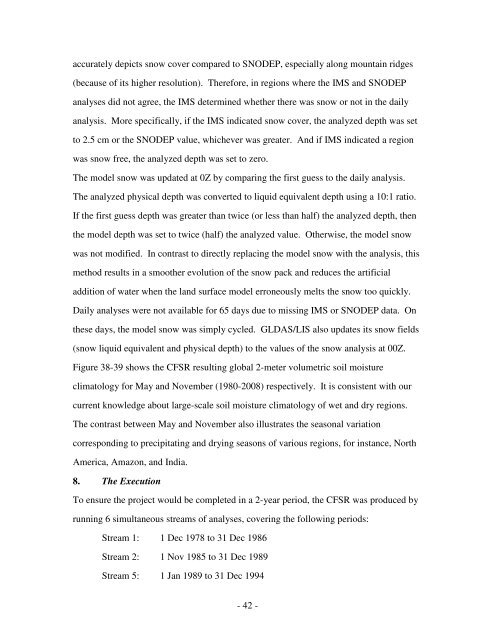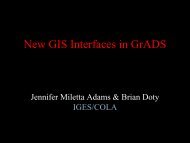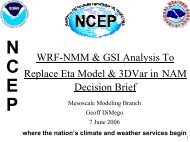The NCEP Climate Forecast System Reanalysis - NOAA National ...
The NCEP Climate Forecast System Reanalysis - NOAA National ...
The NCEP Climate Forecast System Reanalysis - NOAA National ...
You also want an ePaper? Increase the reach of your titles
YUMPU automatically turns print PDFs into web optimized ePapers that Google loves.
accurately depicts snow cover compared to SNODEP, especially along mountain ridges(because of its higher resolution). <strong>The</strong>refore, in regions where the IMS and SNODEPanalyses did not agree, the IMS determined whether there was snow or not in the dailyanalysis. More specifically, if the IMS indicated snow cover, the analyzed depth was setto 2.5 cm or the SNODEP value, whichever was greater. And if IMS indicated a regionwas snow free, the analyzed depth was set to zero.<strong>The</strong> model snow was updated at 0Z by comparing the first guess to the daily analysis.<strong>The</strong> analyzed physical depth was converted to liquid equivalent depth using a 10:1 ratio.If the first guess depth was greater than twice (or less than half) the analyzed depth, thenthe model depth was set to twice (half) the analyzed value. Otherwise, the model snowwas not modified. In contrast to directly replacing the model snow with the analysis, thismethod results in a smoother evolution of the snow pack and reduces the artificialaddition of water when the land surface model erroneously melts the snow too quickly.Daily analyses were not available for 65 days due to missing IMS or SNODEP data. Onthese days, the model snow was simply cycled. GLDAS/LIS also updates its snow fields(snow liquid equivalent and physical depth) to the values of the snow analysis at 00Z.Figure 38-39 shows the CFSR resulting global 2-meter volumetric soil moistureclimatology for May and November (1980-2008) respectively. It is consistent with ourcurrent knowledge about large-scale soil moisture climatology of wet and dry regions.<strong>The</strong> contrast between May and November also illustrates the seasonal variationcorresponding to precipitating and drying seasons of various regions, for instance, NorthAmerica, Amazon, and India.8. <strong>The</strong> ExecutionTo ensure the project would be completed in a 2-year period, the CFSR was produced byrunning 6 simultaneous streams of analyses, covering the following periods:Stream 1: 1 Dec 1978 to 31 Dec 1986Stream 2: 1 Nov 1985 to 31 Dec 1989Stream 5: 1 Jan 1989 to 31 Dec 1994- 42 -





